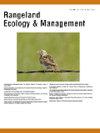以科学为依据的战略框架,用于管理萨格布鲁什生物群落中的入侵一年生草本植物
IF 2.4
3区 环境科学与生态学
Q2 ECOLOGY
引用次数: 0
摘要
在过去的 20 年中,北美鼠尾草生物群落每年损失 50 多万公顷完好或基本完好的鼠尾草植物群落。这种损失大部分与入侵性一年生草(IAGs)的扩展和填充有关。在受干扰的环境中,这些物种对本地多年生草类具有很强的竞争力,它们所创造的燃料条件既增加了点火的可能性,也使野火更容易在大片土地上蔓延。鉴于目前 IAG 在已烧毁和未烧毁牧场中的扩张速度,我们建议在整个牧场范围内转变管理模式,从机会主义和被动式管理转变为在空间上优先维护基本完好的未受入侵区域,并在战略地点改善受入侵栖息地的框架。我们创建了一个框架,并利用地理空间叠加法绘制了整个生物群落的优先事项地图,目标区域包括:通过预防 IAG 的活动维护大片未受侵袭的区域,将其作为自然资源锚地;改善管理最有可能成功恢复大片完整地貌的区域;以及在必要时遏制 IAG 的侵袭。然后,我们提供了三个案例研究,以说明这些概念和地图产品在多种尺度上的应用。我们的地图产品使用区域数据源在生物群落尺度上运行,还需要其他数据源为当地保护规划提供信息。然而,我们的基本战略管理原则(1)保持我们最不能承受 IAGs 损失的完好无损和未被侵蚀的区域,(2)改善我们有合理恢复成功可能性的区域,以及(3)遏制我们必须遏制的问题,这些原则是及时的、相关的,并且可以从生物群落扩展到地方层面。本文章由计算机程序翻译,如有差异,请以英文原文为准。
A Strategic and Science-Based Framework for Management of Invasive Annual Grasses in the Sagebrush Biome
In the last 20 years, the North American sagebrush biome has lost over 500 000 ha of intact and largely intact sagebrush plant communities on an annual basis. Much of this loss has been associated with expansion and infilling of invasive annual grasses (IAGs). These species are highly competitive against native perennial grasses in disturbed environments, and create fuel conditions that increase both the likelihood of fire ignition and the ease of wildfire spread across large landscapes. Given the current rate of IAG expansion in both burned and unburned rangelands, we propose a range-wide paradigm shift from opportunistic and reactive management, to a framework that spatially prioritizes maintenance of largely intact, uninvaded areas and improvement of invaded habitats in strategic locations. We created a framework accompanied by biome-wide priority maps using geospatial overlays that target areas to MAINTAIN large, uninvaded areas as natural resource anchors through activities to prevent IAGs, IMPROVE areas where management success in restoring large, intact landscapes is most likely, and CONTAIN IAG infestations where necessary. We then offer three case studies to illustrate the use of these concepts and map products at multiple scales. Our map products operate at the biome scale using regional data sources and additional data sources will be needed to inform local conservation planning. However, the basic strategic management principles of (1) maintaining the intact and uninvaded areas that we can least afford to lose to IAGs, (2) improving areas where we have a reasonable likelihood of restoration success, and (3) containing problems where we must, are timely, relevant, and scalable from the biome to local levels.
求助全文
通过发布文献求助,成功后即可免费获取论文全文。
去求助
来源期刊

Rangeland Ecology & Management
农林科学-环境科学
CiteScore
4.60
自引率
13.00%
发文量
87
审稿时长
12-24 weeks
期刊介绍:
Rangeland Ecology & Management publishes all topics-including ecology, management, socioeconomic and policy-pertaining to global rangelands. The journal''s mission is to inform academics, ecosystem managers and policy makers of science-based information to promote sound rangeland stewardship. Author submissions are published in five manuscript categories: original research papers, high-profile forum topics, concept syntheses, as well as research and technical notes.
Rangelands represent approximately 50% of the Earth''s land area and provision multiple ecosystem services for large human populations. This expansive and diverse land area functions as coupled human-ecological systems. Knowledge of both social and biophysical system components and their interactions represent the foundation for informed rangeland stewardship. Rangeland Ecology & Management uniquely integrates information from multiple system components to address current and pending challenges confronting global rangelands.
 求助内容:
求助内容: 应助结果提醒方式:
应助结果提醒方式:


